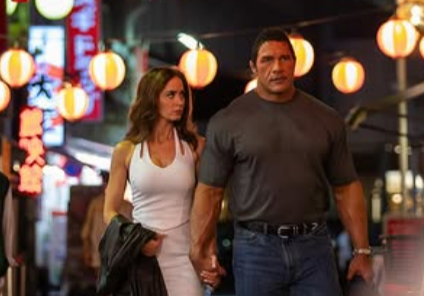The Rock’ Looks Completely Unrecognizable With Hair in New Film and the Internet Can’t Get Over It!

Imagine if Superman suddenly walked into a room in disguise and no one recognized him. That’s exactly what happened when Dwayne “The Rock” Johnson unveiled his shocking transformation for The Smashing Machine. Known for his bald head, towering physique, and magnetic grin, Johnson has been a constant fixture in Hollywood’s landscape of indestructible heroes. But now, with a head full of dark curls, a bruised face, and the worn-out eyes of a man who’s seen too much, he’s turned that image on its head.
The internet couldn’t believe it. “Is that really him?” flooded comment sections across platforms. Fans were stunned, some confused, others impressed. The makeover was so convincing, even longtime followers had to do a double take. But this change runs deeper than wigs and prosthetics 13it’s a signal. A signal that even icons can evolve, shed skin, and reach for something real.
Because this isn’t just a new look for Johnson it’s a bold step toward a different kind of storytelling. One rooted not in spectacle, but in substance.
A Face We Thought We Knew
Dwayne Johnson has always been instantly recognizable. The bald head. The arched eyebrow. The confident smirk and steel-cut jawline. For over a decade, he’s carried a brand of consistency physically, emotionally, and cinematically that audiences have come to expect. He hasn’t just played characters; he’s built a global persona that’s become larger than any one film. But in The Smashing Machine, that familiarity dissolves completely.
When images from the film first emerged, fans were stunned. Johnson, now sporting thick black curls, facial prosthetics, and a completely altered demeanor, looked like a different man altogether. “That’s not The Rock,” became a common reaction across social media. It wasn’t just the hair though seeing him with a full head of it for the first time since his early WWE days was shocking it was the total reshaping of his facial features and the subdued presence he carried in the scenes. The usual polish and bravado had been replaced with vulnerability and weariness.
A look at The Rock in ‘THE SMASHING MACHINE’ 🎞️🍿 pic.twitter.com/ww7xioxtzG
— WrestlingWorldCC (@WrestlingWCC) April 28, 2025
One photo from the set shows Johnson sitting shirtless in a boxing ring, cooling off between takes, surrounded by trainers. He’s hunched, tired, and distant a far cry from the energized, spotlight-ready figure he usually presents. The transformation was so drastic that some fans said it took them half the trailer to even realize it was him. Others thought he resembled fellow wrestling stars like John Cena or Dave Bautista more than himself.
The costume and makeup departments deserve credit for their masterful work, but it’s not just about external changes. Johnson altered his posture, his cadence, even his energy. And it worked. For the first time in years, audiences weren’t seeing “The Rock.” They were seeing Mark Kerr. That’s what makes the transformation so powerful not that he changed his look, but that he let go of his identity to fully inhabit someone else’s.
In a world where celebrity images are carefully curated and relentlessly consistent, Johnson’s willingness to become unrecognizable is more than surprising it’s brave.
Why This Transformation Matters
Dwayne Johnson’s metamorphosis into Mark Kerr goes beyond prosthetics and physical preparation it marks a significant shift in purpose. For years, Johnson has ruled Hollywood’s blockbuster machine, often playing variations of his charismatic, invincible self. This time, he didn’t just want a new role. He wanted a challenge that would stretch him as an artist and human being.
Portraying Kerr a fighter celebrated for his dominance in the ring and tormented by struggles outside of it demanded vulnerability. Kerr’s story isn’t glamorous. It’s filled with painkiller addiction, broken relationships, career highs overshadowed by personal collapse. Johnson didn’t just study Kerr; he trained with him, learned his habits, adopted his voice, and immersed himself in the psyche of a man fighting battles most people never see.
This isn’t the kind of film built to showcase stunts or box office stats. It’s a character study. A story about damage, survival, and the complexity of pain. And for Johnson, it was the role that reawakened his artistic instincts. “I’m at a point in my career where I want to make films that matter,” he told Variety. “I want to explore humanity, struggle, and pain.”
Co-star Emily Blunt echoed that this role demanded a level of emotional immersion she hadn’t seen from Johnson before. MMA legend Bas Rutten described scenes where Johnson so deeply embodied Kerr’s persona that it felt “scary,” as if Kerr himself had stepped back into the room.
This transformation matters because it’s a rejection of safe roles and an embrace of creative risk. It shows that reinvention isn’t reserved for the beginning of a career it’s available at any stage, if you’re willing to chase discomfort. For Johnson, this is more than acting. It’s a statement: the desire to be taken seriously as a storyteller, and the courage to step into the ring, not just as a performer, but as a man seeking deeper truths.
The Courage to Disappear (and Reappear)

For someone like Dwayne Johnson whose image is not just a brand but a cultural monolith vanishing into a role is no small feat. In Hollywood, visibility is power, and consistency keeps that power intact. But in The Smashing Machine, Johnson made a conscious choice to disappear.
Disappearing isn’t just about physical transformation. It’s about setting ego aside, letting go of control, and fully submitting to a character’s trut even when that truth is messy, flawed, and uncomfortable. In Mark Kerr, Johnson found a man who was once invincible in the cage, yet painfully human outside of it. Addiction, identity crises, and emotional instability defined much of Kerr’s journey. Portraying that raw reality required Johnson to strip back the layers of performance he had spent years perfecting.
There’s a particular kind of courage in letting go of what’s expected. Johnson could have coasted another action franchise, another billion-dollar hit. Instead, he chose to be nervous again. As he shared on The Pat McAfee Show, the role made him feel the same fear he had early in his career, and that fear became fuel. It reminded him what it feels like to be creatively alive.
Actors often talk about “disappearing into a role,” but rarely do global celebrities like Johnson achieve it. Yet, by embracing discomfort and stepping into a story far removed from his public persona, he’s not just proving something to audiences he’s rediscovering something within himself.
And here’s the truth that lingers beyond the movie: disappearing isn’t failure; it’s transformation. Sometimes, the most powerful thing a person can do is become unrecognizable not to escape themselves, but to return as someone truer, deeper, more whole.
Fans, Fame, and the Fluidity of Identity

When The Smashing Machine trailer dropped, the internet erupted not with critique or controversy, but with confusion and awe. “That can’t be The Rock,” some said. “Is that really him?” others asked. Even long-time fans struggled to reconcile the face on screen with the man they thought they knew. This collective reaction reveals something deeper than shock value it exposes how tightly we associate identity with appearance, especially in the world of fame.
Dwayne Johnson has spent decades cultivating a familiar image. His bald head, chiseled jaw, and massive frame have become instantly recognizable markers of his brand. When those markers changed, so did people’s perception of who he was. It’s not just that he looked different. It’s that he disrupted the mental blueprint fans had constructed. The reaction wasn’t just visual it was existential.
Some fans praised the change, calling the makeup “Oscar-worthy” and his commitment to the role inspiring. Others joked about how unrecognizable he looked, comparing him to other wrestlers or poking fun at his hair. But underneath the humor and hyperbole lies a truth about how identity is shaped not only by who we are, but by how others see us, and how consistently we present ourselves to the world.

Fame often demands constancy. Audiences expect their heroes to remain unchanged, to deliver the same persona again and again. But identity, at its core, is fluid. People grow, evolve, and sometimes radically redefine themselves. What makes Johnson’s transformation so impactful is that it challenges this illusion of permanence. He reminds us that image is a choice not a prison and reinvention is not betrayal, but evolution.
Even in our own lives, we experience this tension. We’re often boxed in by the expectations of family, friends, or past versions of ourselves. But like Johnson’s leap into the unfamiliar, change can be liberating. When we allow room for our identity to shift when we accept that who we were isn’t all we can be we give ourselves permission to grow. And that’s where true power lies: not in holding onto who we’ve always been, but in boldly becoming someone new.
Reinvention Is Power
Dwayne Johnson’s transformation in The Smashing Machine is more than a physical makeover it’s a metaphor for the human capacity to evolve. For years, he embodied the ideal of strength and stability, a figure who didn’t waver. But with this role, he’s chosen to waver. To shift. To challenge his own narrative. And in doing so, he’s not only expanded his craft he’s reminded us that reinvention isn’t just possible, it’s necessary.
Whether we’re in the spotlight or not, we’re all performers to some extent projecting roles shaped by expectation, comfort, or fear. But the courage to shed those roles, to step into a version of ourselves that feels less familiar yet more truthful, is where transformation begins.
Johnson didn’t need this film to prove anything. He’s already successful by every metric. But he took the risk anyway because growth isn’t about proving, it’s about becoming. Becoming more honest. More human. More whole.
And that’s the takeaway: No matter how recognizable or unrecognizable you may seem to others, the journey of changing into who you’re truly meant to be is always worth it.
Featured Image from Instagram @therock
Loading...

